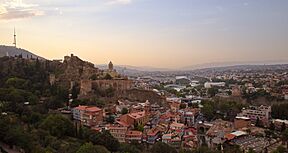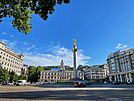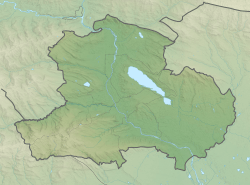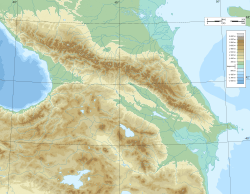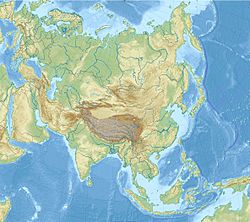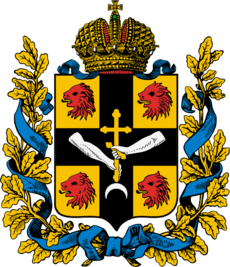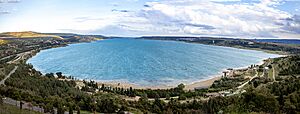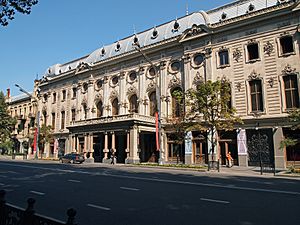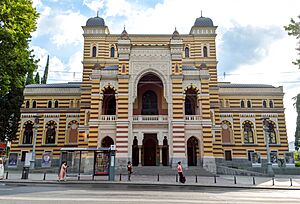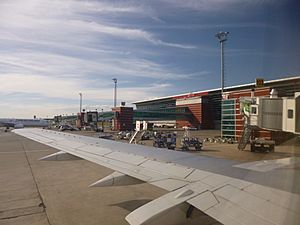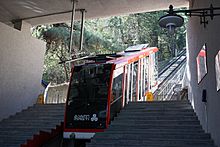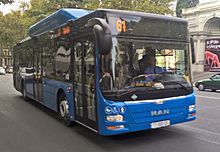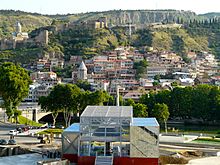Tbilisi facts for kids
Quick facts for kids
Tbilisi
თბილისი
Tiflis
|
|||
|---|---|---|---|
|
Top to bottom and left to right: Old Tbilisi and the Narikala Fortress at dusk; Freedom Square; Bridge of Peace and Sioni Cathedral, with Sameba in the background; Old Town as viewed from Metekhi.
|
|||
|
|||
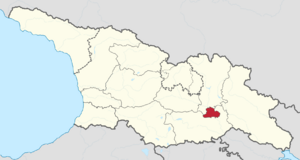
Tbilisi highlighted in Georgia
|
|||
| Country | |||
| Established | AD 455 | ||
| Government | |||
| • Type | Mayor–Council | ||
| • Body | Tbilisi Sakrebulo | ||
| Area | |||
| • Capital city | 504.2 km2 (194.7 sq mi) | ||
| • Metro | 726 km2 (280 sq mi) | ||
| Highest elevation | 770 m (2,530 ft) | ||
| Lowest elevation | 380 m (1,250 ft) | ||
| Population
(2024)
|
|||
| • Capital city | 1,258,526 | ||
| • Density | 2,496.08/km2 (6,464.8/sq mi) | ||
| • Metro | 1,485,293 | ||
| Demonym(s) | Tbilisian Tbiliseli (In Georgian) |
||
| Population by ethnicity | |||
| • Georgians | 89.9% | ||
| • Armenians | 4.8% | ||
| • Azerbaijanis | 1.4% | ||
| • Russians | 1.2% | ||
| • Yazidis | 1.0% | ||
| • Others | 1.7% | ||
| GDP | |||
| • Capital city | ₾ 32.2 billion (US$ 11.0 billion) · 1st |
||
| • Per capita | ₾ 26,769 (US$ 9,200) · 1st |
||
| Time zone | UTC+4 (Georgian Time) | ||
| Area code(s) | +995 32 | ||
| HDI (2024) | 0.837 | ||
Tbilisi (pronounced tə-BIL-ee-see) is the capital and largest city of Georgia. It sits on the banks of the Kura River. About 1.2 million people live here, which is about one-third of Georgia's total population.
King Vakhtang I of Iberia founded Tbilisi in the 5th century AD. Since then, it has been the capital for many Georgian kingdoms and republics. From 1801 to 1917, when it was part of the Russian Empire, Tbilisi was a very important city for the Caucasus region.
Tbilisi is located where Europe and Asia meet. This made it a key spot for trade along the famous Silk Road. Because of its location, many powerful groups wanted to control it throughout history. Even today, Tbilisi is a major route for energy and trade. The city's long history is visible in its buildings, which mix different styles like medieval, neoclassical, and modern.
Many different cultures, ethnic groups, and religions have called Tbilisi home. Most people living there are Eastern Orthodox Christians. Popular places to visit include the Sameba and Sioni cathedrals, Freedom Square, and the old Narikala Fortress. The weather in Tbilisi is usually warm, from 20 to 32°C in summer, and cool, from -1 to 7°C in winter.
Contents
Understanding Tbilisi's Name
The name "Tbilisi" comes from an old Georgian word meaning "warm place." This name was chosen because the area has many natural sulfur hot springs.
Before 1936, the city was often called Tiflis in English and other languages. This name came from a Persian pronunciation.
In 1936, the Soviet government changed the official Russian name to "Tbilisi" to match the local Georgian name more closely. Many other languages then started using the new name. However, some languages, like Turkish and German, still use a version of "Tiflis."
A Look at Tbilisi's History
 Kingdom of Iberia 450s–530s
Kingdom of Iberia 450s–530s Sasanian Empire (Sasanian Iberia) 530s–570s
Sasanian Empire (Sasanian Iberia) 530s–570s Principality of Iberia 570s–730s
Principality of Iberia 570s–730s- Emirate of Tbilisi 730s–1122
 Kingdom of Georgia 1122–1490
Kingdom of Georgia 1122–1490 Kingdom of Kartli 1490–1762
Kingdom of Kartli 1490–1762 Kingdom of Kartli-Kakheti 1762–1801
Kingdom of Kartli-Kakheti 1762–1801 Russian Empire 1801–1917
Russian Empire 1801–1917 Russian Republic 1917
Russian Republic 1917 Transcaucasian Commissariat 1917–1918
Transcaucasian Commissariat 1917–1918 Transcaucasian Democratic Federative Republic 1918
Transcaucasian Democratic Federative Republic 1918 Democratic Republic of Georgia 1918–1921
Democratic Republic of Georgia 1918–1921 Georgian Soviet Socialist Republic 1921–1922
Georgian Soviet Socialist Republic 1921–1922 Union of Soviet Socialist Republics 1922–1991
Union of Soviet Socialist Republics 1922–1991 Georgia 1991–present
Georgia 1991–present
Early Beginnings of Tbilisi
Archaeologists have found signs that people lived in the Tbilisi area since the early Bronze Age. Some stone tools found are even older, from the Paleolithic age.
A popular story says that in 458 AD, the area where Tbilisi now stands was covered in forests. King Vakhtang I of Iberia was hunting with his falcon. The falcon caught a pheasant, and both birds fell into a hot spring. They died from the hot water. The king was so amazed by the hot springs that he decided to build a city there.
King Dachi of Iberia, Vakhtang I's son, later moved the capital of Iberia from Mtskheta to Tbilisi. He started building a fortress wall around the city. From the 6th century, Tbilisi grew steadily. Its location on important trade routes between Europe and Asia helped it become a busy city.
Times of Foreign Rule
Tbilisi's great location for trade also made it a target. Many powerful empires wanted to control it. These included the Roman Empire, Sassanid Persia, Muslim Arabs, and the Byzantine Empire.
From 570 to 580, the Persians ruled Tbilisi. Then, in 627, Byzantine and Khazar armies attacked the city. Later, in 736–738, Arab armies took control. They set up an emirate (a type of kingdom) there. Arabic coins were even made in Tbilisi.
In 764, the Khazars attacked Tbilisi again. In 853, Arab armies invaded to bring the city back under their control. Arab rule lasted until about 1050. In 1065, the Seljuk Sultan Alp Arslan also took over Tbilisi for a short time.
Tbilisi Becomes Georgia's Capital
In 1121, after a big battle against the Seljuks, King David IV of Georgia captured Tbilisi. In 1122, David moved his home from Kutaisi to Tbilisi. He made it the capital of a united Georgian State. This started Georgia's "Golden Age."
From the 12th to 13th centuries, Tbilisi became a powerful city. It had a strong economy and produced amazing art and culture. By the late 12th century, about 100,000 people lived in Tbilisi. It was a major center for literature and culture. During Queen Tamar's rule, the famous poet Shota Rustaveli wrote his epic poem The Knight in the Panther's Skin in Tbilisi. This time is often called Georgia's Golden Age or Renaissance.
Mongol Rule and Other Challenges
Tbilisi's Golden Age did not last forever. In 1226, the Khwarezmian Empire captured Tbilisi. They caused a lot of destruction. This made the city weak for future attacks.
In 1236, after losing battles to the Mongols, Georgia came under Mongol rule. Georgia kept some independence, but the Mongols greatly influenced Tbilisi for the next 100 years. In the 1320s, the Mongols left Georgia. Tbilisi became the capital of an independent Georgian state again. However, the Black Death plague hit the city in 1366.
Between the late 14th and late 18th centuries, Tbilisi was often ruled by foreign powers. The city was even burned down completely several times. In 1386, Tamerlane's armies invaded and destroyed Tbilisi many times. In 1440, Jahan Shah from Persia also invaded and destroyed the city.
Persian Influence
From the early 1500s, Tbilisi and the Georgian kingdoms became part of Safavid Iran. In 1522, a large Safavid army was stationed in Tbilisi. After the death of Shah Ismail I, King David X of Kartli drove out the Iranians. During this time, many parts of Tbilisi were rebuilt.
However, the Safavids returned. From 1614 to 1747, Tbilisi was an important city under Iranian rule. It was the home of the Iranian-appointed kings of Kartli. In 1783, Georgia's rulers sought protection from Russia. Despite this, the Iranian ruler Agha Mohammad Khan Qajar captured and destroyed Tbilisi in 1795. He wanted to bring the region back under Iranian control.
Russian Control
In 1801, the Russian Empire took over the Georgian Kingdom of Kartli-Kakheti, with Tbilisi as its capital. Russia made its rule permanent with a treaty in 1813.
Under Russian rule, Tbilisi was called Tiflis. It became the main city of the Tiflis Governorate in 1846. Russian leaders built new buildings in European styles. They also built roads and railroads to connect Tbilisi to other Russian cities. By the 1850s, Tbilisi was again a major center for trade and culture. Many famous writers and artists lived or visited Tbilisi. The main new street built was Golovin Avenue, now called Rustaveli Avenue. For much of the early 19th century, Armenians were the largest ethnic group in Tbilisi.
Short Period of Independence
After the Russian Revolution in 1917, Tbilisi became the capital of the short-lived Transcaucasian Democratic Federative Republic. This republic included Georgia, Armenia, and Azerbaijan. In 1918, the independence of these three nations was declared in Tbilisi.
Tbilisi then became the capital of the Democratic Republic of Georgia until 1921. During this time, Tbilisi State University was founded in 1918. This made Tbilisi the first university city in the Caucasus. On February 25, 1921, the Russian Soviet Red Army invaded Tbilisi. After tough fighting, they took control and declared Soviet rule.
Soviet Rule in Tbilisi
From 1921, Tbilisi was under Soviet rule. It was the capital of the Transcaucasian SFSR (which included Armenia, Azerbaijan, and Georgia) until 1936. After that, it was the capital of the Georgian Soviet Socialist Republic until 1991.
During Soviet times, Tbilisi's population grew a lot. The city became more industrial, with many factories. It also became an important cultural center for the Soviet Union. In the 1970s and 1980s, the "Old Town" area of Tbilisi was rebuilt.
Tbilisi saw protests against Russian policies in 1956. More peaceful protests happened in 1978. In 1989, a peaceful protest turned violent, known as the April 9 tragedy.
After Independence
Since the Soviet Union broke up in 1991, Tbilisi has faced some tough times. There was a short civil war in the city from late 1991 to early 1992. Crime and corruption were high for a while. Many people became poor because of job losses.
In November 2003, large protests happened after unfair elections. More than 100,000 people went into the streets. This led to the Rose Revolution, which brought peaceful change. Since 2003, Tbilisi has become much more stable. Crime rates have dropped, the economy has improved, and new buildings are being built.
During the 2008 South Ossetia war, Russian air attacks hit the Tbilisi area. After the war, many big projects started. These included new roads and public transport improvements. In June 2015, a big flood killed at least twenty people. Animals from the city's zoo even escaped into the streets.
Tbilisi's Geography
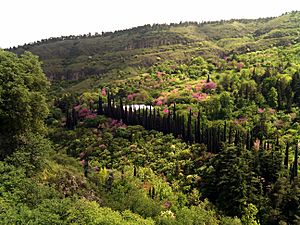
Where is Tbilisi Located?
Tbilisi is in the South Caucasus region. It is in Eastern Georgia, on both sides of the Kura River. The city is like an amphitheater, surrounded by mountains on three sides.
The city's height above sea level ranges from 380 to 770 meters. To the north, it's bordered by the Saguramo Range. To the east and south-east, there's the Iori Plain. To the south and west, there are parts of the Trialeti Range.
Tbilisi's landscape is quite hilly. The part of the city on the left side of the Kura River stretches for over 30 kilometers. The part on the right side is built along the foothills of the Trialeti Range. These mountains make it hard to build new areas on the right bank. This creates very crowded areas in some parts, while other areas remain undeveloped due to the difficult land.
North of the city, there is a large reservoir called the Tbilisi Sea. It is filled by irrigation canals.
Tbilisi's Climate and Weather
Tbilisi has a humid temperate climate. This means it has hot, humid summers and moderately cold, dry winters. Like other parts of Georgia, Tbilisi gets a good amount of rain all year round.
The city's weather is affected by dry air from Central Asia and Siberia, and by oceanic air from the Atlantic and Black Sea. The Greater Caucasus Mountains to the north block cold air from Russia. This gives Tbilisi a milder climate compared to other cities at the same latitude.
The average yearly temperature in Tbilisi is 13.8°C. January is the coldest month, averaging 2.7°C. July is the hottest, averaging 25.4°C. Temperatures can reach or go above 32°C about 22 days a year. The lowest temperature ever recorded was -24.4°C in January 1883. The highest was 42.0°C in July 1882.
Tbilisi gets about 511.5 mm of rain each year. May is the wettest month, and January is the driest. Snow falls about 15–25 days a year. The mountains around the city often trap clouds, leading to long periods of rainy or cloudy weather, especially in spring and autumn.
People and Religions in Tbilisi
| Year | Georgians | % | Armenians | % | Russians | % | Total |
|---|---|---|---|---|---|---|---|
| 1780 | 50,000 | 66.7% | 10,000 | 13.3% |
|
|
75,000 |
| 1790 | 44,000 | 61.1% | 12,000 | 16.7% |
|
|
72,000 |
| 1801-3 | 4,300 | 21.5% | 14,860 | 74.3% |
|
|
20,000 |
| 1864/65 winter | 14,878 | 24.8% | 28,404 | 47.3% | 12,462 | 20.7% | 60,085 |
| 1864/65 summer | 14,787 | 20.8% | 31,180 | 43.9% | 12,142 | 17.1% | 71,051 |
| 1876 | 22,156 | 21.3% | 37,610 | 36.1% | 30,813 | 29.6% | 104,024 |
| 1897 | 42,206 | 26.4% | 47,133 | 29.5% | 44,823 | 28.1% | 159,590 |
| 1916 | 37,584 | 10.8% | 149,294 | 43.1% | 91,997 | 26.5% | 346,766 |
| 1926 | 112,014 | 38.1% | 100,148 | 34.1% | 45,937 | 15.6% | 294,044 |
| 1939 | 228,394 | 44% | 137,331 | 26.4% | 93,337 | 18% | 519,220 |
| 1959 | 336,257 | 48.4% | 149,258 | 21.5% | 125,674 | 18.1% | 694,664 |
| 1970 | 511,379 | 57.5% | 150,205 | 16.9% | 124,316 | 14% | 889,020 |
| 1979 | 653,242 | 62.1% | 152,767 | 14.5% | 129,122 | 12.3% | 1,052,734 |
| 1989 | 824,412 | 66.1% | 150,138 | 12.0% | 124,867 | 10.0% | 1,246,936 |
| 2002 | 910,712 | 84.2% | 82,586 | 7.6% | 32,580 | 3% | 1,081,679 |
| 2014 | 996,804 | 89.9% | 53,409 | 4.8% | 13,350 | 1.2% | 1,108,717 |
Tbilisi is a city with many different ethnic groups. About 90% of the people are ethnic Georgians. There are also many Armenians, Russians, and Azerbaijanis. Other groups include Ossetians, Abkhazians, Ukrainians, Greeks, Jews, and Yazidis.
Religious Diversity in Tbilisi
More than 95% of Tbilisi residents are Christian. Most of them belong to the Georgian Orthodox Church. The Russian Orthodox Church and the Armenian Apostolic Church also have many followers.
A small number of people (about 1.5%) practice Islam, mostly Shia Islam. About 0.1% of the population practices Judaism. You can also find a Roman Catholic church and a Yazidi temple in the city.
Sports in Tbilisi
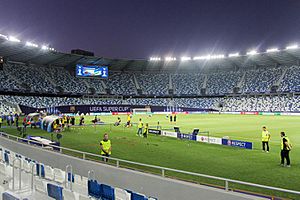
Before the 19th century, sports like horse-riding (especially polo), wrestling, boxing, and target shooting were very popular. When the Russian Empire took over, more Western sports like billiards and fencing became common.
During the Soviet era, sports popular in Europe and the US became more widespread. Tbilisi also built many sports facilities. By 1978, the city had about 250 sports venues. These included swimming pools, basketball courts, volleyball facilities, and stadiums.
The largest stadium in Tbilisi is the Dinamo Arena, which can hold 55,000 people. The Mikheil Meskhi Stadium is the second largest. The Sports Palace hosts basketball games and tennis tournaments.
Football is the most popular sport in Tbilisi. Rugby and basketball are also very popular. Other sports include wrestling, tennis, swimming, and water polo. Tbilisi has professional teams for football and rugby, and many wrestling clubs.
Tbilisi's main football club, FC Dinamo Tbilisi, won the European UEFA Cup Winners' Cup in 1980–1981. The basketball club Dinamo Tbilisi won the Euroleague in 1962. Tbilisi also hosted some matches for the EuroBasket 2022 at the new 10,000-seat Tbilisi Arena.
Media in Tbilisi
Most of Georgia's media companies are based in Tbilisi. This includes television channels, newspapers, and radio stations. Popular TV channels include Rustavi 2, Imedi, and Mtavari Arkhi.
Tbilisi has several newspapers. Some well-known ones are 24 Saati ("24 Hours") and Rezonansi ("Resonance"). There are also English-language newspapers like The Messenger and The Georgian Times. Popular radio stations include Imedi Radio and Fortuna.
Tbilisi's Culture
Architecture and Buildings
Tbilisi's buildings show a mix of styles. You can see Georgian, Byzantine, Neoclassical, Art Nouveau, and Soviet modern designs. Not many buildings survived the destruction of 1795. So, most historic buildings are from the time of Russian Imperial rule (1801–1917).
The oldest parts of the city were rebuilt on their medieval street plans. Some old houses were even built on much older foundations. Downtown Tbilisi was planned by Russian authorities. These areas have a Western look, with styles popular in Europe at the time.
Tbilisi is famous for its many Art Nouveau buildings. This style was popular from the 1890s until the end of Russian rule. After the Soviet Union took over, they built more modern, experimental buildings.
After World War II, Tbilisi grew very quickly. New neighborhoods appeared on the city's edges. Georgian architects created some interesting Soviet buildings. Since the Soviet Union fell, there has been a lot of new construction. New tall buildings are appearing in the city.
Art and Museums
The Georgian National Museum has several important museums. This includes the Art Museum of Georgia. The Museum of Modern Art opened in 2012. Other museums include the Giorgi Leonidze State Museum of Literature.
Performing Arts and Theater
Tbilisi has important places for theater and music. These include the Tbilisi State Conservatoire and the Tbilisi Opera and Ballet Theatre. There are also famous theaters like the Shota Rustaveli State Academic Theatre.
Film Festival
The Tbilisi International Film Festival (TIFF) is held in the city. It started in 2000 and is now hosted by the Cinema Art Center, Prometheus.
World Book Capital
In 2021, UNESCO named Tbilisi the World Book Capital. This was a special honor for the city.
Tourism in Tbilisi
Georgia is becoming a popular place for tourists. This has made Tbilisi a well-known travel spot. In 2019, over 9 million international visitors came to Georgia. Tbilisi has seen many new hotels and tourist services.
It is now a top tourist spot in the region. The city offers beautiful views, different types of architecture, museums, and cultural events. You can also enjoy traditional Georgian food and international restaurants. Tbilisi is known as a "melting pot" of cultures because of its diverse history.
Main Places to See
Tbilisi has many important landmarks and sights. These include the Parliament building and the Supreme Court. The Sameba Cathedral and the Bridge of Peace are also famous. Many state museums are in Tbilisi.
Some of the most notable historic places are:
- The Narikala fortress (built between the 4th and 17th centuries).
- Anchiskhati Basilica (from the 6th century).
- Sioni Cathedral (from the 8th century).
- The Church of Metekhi.
- The Open Air Museum of Ethnography.
- The famous Sulfur Baths in Abanotubani.
Nightlife and Entertainment
Tbilisi has a growing nightclub scene. It has become popular internationally in recent years. Clubs like Bassiani and Mtkvarze host famous DJs. The city also has several underground LGBTQ+ venues.
Tbilisi's Economy
Tbilisi is the economic heart of Georgia. In 2022, it produced more than half of the country's total economic output. The service industry is very important, especially trade. This shows Tbilisi's role as a key place for transport and business in the South Caucasus.
The manufacturing sector (making goods) is smaller. However, it is still much larger in Tbilisi than in other parts of Georgia. The unemployment rate in Tbilisi is higher than the national average.
Getting Around Tbilisi
Tbilisi's public transport is managed by the Transport and Urban Development Agency. For many years, private cars were prioritized. But since the 2010s, the city has invested a lot in public transport.
Today, Tbilisi has an international airport, a metro system, national trains, buses, minibuses, taxis, and cable cars. There are also bike lanes and a funicular.
Airport Services
Shota Rustaveli Tbilisi International Airport is Tbilisi's only international airport. It is about 18 kilometers southeast of the city center. In 2022, it served almost 3 million passengers. It is the busiest airport in Georgia.
The airport has grown quickly. It is a main base for Georgian Airways. Many international airlines fly to major cities in Europe and Asia from Tbilisi. In 2016, Tbilisi International Airport started using solar energy. It became the first "green airport" in the Caucasus region.
Natakhtari Airfield, north of Tbilisi, is a smaller airport. It offers domestic flights to other Georgian cities like Batumi and Mestia.
Metro System
The Tbilisi Metro is a subway system. Over 400,000 trips are made on it every day. It was the fourth metro system built in the Soviet Union. Construction started in 1952 and finished in 1966.
The system has two lines and 23 stations. Many stations are beautifully decorated, typical of Soviet-built metros. Trains run from 6:00 AM to midnight. Some parts of the metro run above ground because of the hilly land.
In 2020, the city announced big plans to upgrade the metro. All stations will be renovated. Tbilisi will also buy 40 new, modern train cars. This will be the first major upgrade to the trains in over 50 years. A third line is planned to connect central Tbilisi with the airport.
Rail Travel
Tbilisi is the busiest hub for Georgian Railways. The main station is Tbilisi Central Railway Station. From here, you can take trains to other big cities in Georgia. These include Batumi, Zugdidi, and Kutaisi. There are also local train services.
Bus Network
Tbilisi's bus network is a very important part of its transport system. For a long time, the city used many old buses. In August 2020, the mayor announced big changes. The city will have 10 special "Bus Rapid Transit" (TBT) corridors. These will have large, 18-meter-long buses running very often.
The city has bought many new, modern buses since 2016. These include energy-efficient MAN Lion's City buses and BMC and Isuzu city buses. The city plans to buy even more large buses to expand the network.
Cycling in Tbilisi
Cycling has become more popular in Tbilisi recently. For many years, people thought bikes were not good for the city's hilly terrain. However, the city government has started building new bike lanes. This has led more people to use bikes for daily travel.
One of the first major bike lanes opened in 2017. During the COVID-19 pandemic, the city quickly added more pop-up bike lanes. These were in central areas like Vake and along the Kura River. The total length of bike lanes grew from 2 km in 2019 to over 20 km in 2020. The city plans to have 350 km of bike lanes in the future.
Minibus Services
For a long time, minibuses (called marshrutkas) were the main way to get around Tbilisi. They grew popular in the early 2000s when there wasn't enough public funding for transport. In 2019, the company running the yellow minibuses was asked to replace their old vehicles. The city plans to slowly reduce the number of minibuses.
Minibuses have a fixed price for trips within the city. For longer trips outside the city, the fare is higher. Minibuses can be hailed from most streets like taxis.
Aerial Tramways
Historically, Tbilisi had seven different aerial tramways (cable cars). Many closed after the Soviet Union broke up.
Since 2012, a new gondola lift connects Rike Park to the Narikala fortress. Each gondola can carry up to eight people. In 2016, the Turtle Lake aerial tramway reopened after seven years. It connects Vake Park with Turtle Lake. Another Soviet-era tramway reopened in 2021.
One main aerial tram had a big accident in 1990 and has been closed since. It is now being rebuilt with new parts, but keeping the old station design.
Funicular Railway
The Tbilisi funicular reopened in 2012. It is a special railway that goes up a steep hill. It connects Chonkadze Street with Mtatsminda Park. It climbs almost 300 meters in height. The top of the hill is the highest point in the city. It offers great views of Tbilisi. There is also the Tbilisi TV Broadcasting Tower and amusement rides there.
Halfway up the funicular, there is a station near the Mtatsminda Pantheon. This makes it easy to visit the famous burial ground.
Education in Tbilisi
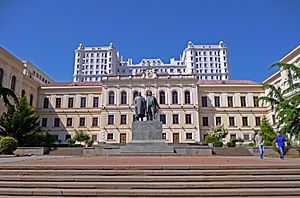
Tbilisi is home to many important universities. These include Tbilisi State Medical University, known for its medical programs.
The biggest Georgian university is Tbilisi State University (TSU). It was founded on February 8, 1918. TSU is the oldest university in the entire Caucasus region. It has about 25,000 students and 5,000 staff members.
Tbilisi State Medical University is the largest medical university in the Caucasus. It started as the Tbilisi Medical Institute in 1918. Today, it has over 7,000 undergraduate students. About a quarter of its students come from other countries.
Georgia's main technical university, Georgian Technical University, is also in Tbilisi. It started in 1922 as part of Tbilisi State University. It became an independent university in 1990.
Three popular private universities in Georgia are in Tbilisi:
- The University of Georgia (Tbilisi) is the largest private university. It has over 8,000 students.
- Caucasus University was started in 2004.
- Free University of Tbilisi was created in 2007 by combining two schools.
Other higher education institutions in Tbilisi include:
- Ilia State University
- Tbilisi State Conservatory
- Shota Rustaveli Theatre and Film University
- Sulkhan-Saba Orbeliani University
- Tbilisi State Academy of Arts
- Caucasus International University
- Tbilisi Medical Academy
- Grigol Robakidze University – Alma Mater
- Georgian American University
- International Black Sea University
- Georgian Institute of Public Affairs
- Agricultural University of Georgia
- International School of Economics (ISET)
- The University of Geomedi
- New Vision University
International Connections
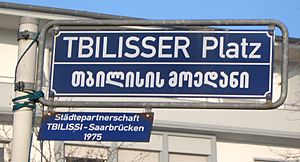
Tbilisi has many connections with cities around the world.
Twin Towns and Sister Cities
Tbilisi is twinned with these cities:
|
Partnerships with Other Cities
Tbilisi also has partnerships with these cities:
Images for kids
-
Tiflis by Mikhail Lermontov, 1837
See also
 In Spanish: Tiflis para niños
In Spanish: Tiflis para niños


